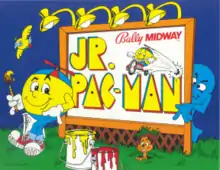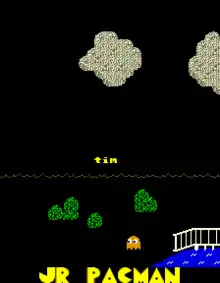Jr. Pac-Man
Jr. Pac-Man is an arcade game, released by Bally Midway on August 13, 1983. It is based on Pac-Man and its derivatives but, like Baby Pac-Man, and Pac-Man Plus, was created without the authorization of Namco. This was one of several games that eventually led to the termination of the licensing agreement between Namco and Bally Midway in 1984. Unlike prior games in the series, the maze in Jr. Pac-Man scrolls horizontally and has no escape tunnels.
| Jr. Pac-Man | |
|---|---|
 Arcade flyer | |
| Developer(s) | Bally Midway Atari, Inc. |
| Publisher(s) | |
| Series | Pac-Man |
| Platform(s) | Arcade, Atari 2600, Commodore 64, MS-DOS |
| Release | Arcade
|
| Genre(s) | Maze |
| Mode(s) | Up to 2 players, alternating turns |
| Arcade system | Namco Pac-Man |
Gameplay

The core gameplay of Jr. Pac-Man similar to its predecessors. The player controls the eponymous Jr. Pac-Man (who wears an animated propeller beanie), and scores points by eating all of the dots in the maze, while four ghosts (Blinky, Pinky, Inky, and Tim) chase him around the maze and attempt to kill him. Eating an energizer turns the ghosts blue, briefly allowing the player to eat them for extra points. Once the maze is cleared, a new maze is presented and the gameplay continues.
The mazes are now two times the width of the monitor and scroll horizontally. A total of seven mazes appear throughout the game, and five of them have six energizers instead of four, but none of them have tunnels that wrap around from one side of the screen to the other.
Bonus items (such as tricycles, kites, and balloons) appear in each round, starting above the ghosts' lair and moving around the maze as in Ms. Pac-Man. As an item encounters dots, it changes them into larger dots that are worth 50 points instead of 10, but they also slow Jr. Pac-Man down more than regular dots. If an item has been out for long enough and encounters an energizer, it self-destructs, taking the energizer with it. When Jr. Pac-Man dies, the larger dots disappear; if there are only a few left, they revert to their original size.
The between-level intermissions show the developing relationship between Jr. Pac-Man and a small red ghost named Yum-Yum who is apparently the daughter of Blinky.
Ports
An Atari 2600 version was released by Atari Corporation in 1986 with mazes that scroll vertically rather than horizontally, but is otherwise a faithful adaptation. The game was later ported to the Commodore 64[1] and IBM PC compatibles.[2]
Ports for the Atari 5200 and the Atari 8-bit family were finished in 1984, but were scrapped along with Super Pac-Man when the home computing and game console divisions of Atari, Inc. were sold to Jack Tramiel.[3][4]
References
- "Commodore 64 version released". Lemon64. Retrieved 16 October 2014.
- PC version released Archived 2010-04-21 at the Wayback Machine
- Reichert, Matt. "Jr. Pac-Man (Atari 5200)". AtariProtos.com. Retrieved 2011-03-05.
- Reichert, Matt. "Jr. Pac-Man (Atari 8-bit)". AtariProtos.com. Retrieved 2011-03-05.
External links
- Jr. Pac-Man at the Killer List of Videogames
- Jr. Pac-Man at the Arcade History database
- Jr. Pac-Man for the Atari 2600 at Atari Mania
- Jr. Pac-Man at Lemon 64
- ClassicGaming.com entry on Jr. Pac-Man with screenshots of all the mazes and cutscenes